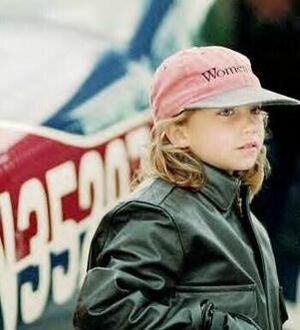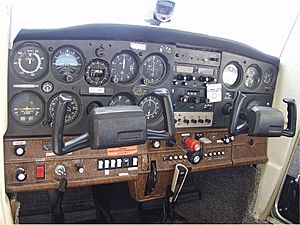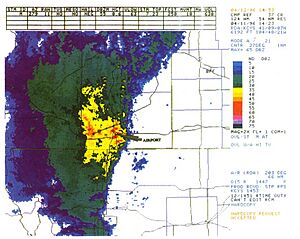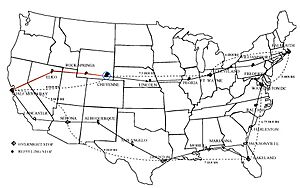Jessica Dubroff facts for kids
Quick facts for kids
Jessica Dubroff
|
|
|---|---|

Dubroff, age 7, leaving on her ill-fated cross-country flight, April 10, 1996
|
|
| Born |
Jessica Whitney Dubroff
May 5, 1988 Falmouth, Massachusetts, U.S.
|
| Died | April 11, 1996 (aged 7) Cheyenne, Wyoming, U.S.
|
| Cause of death | Plane crash |
| Resting place | Mount Hope Cemetery Pescadero, California, U.S. |
| Parent(s) | Lloyd Dubroff Lisa Blair Hathaway |
Jessica Whitney Dubroff (born May 5, 1988 – died April 11, 1996) was a seven-year-old American girl. She became well-known for trying to be the youngest person to fly a small airplane across the United States. Sadly, on the second day of her trip, the plane crashed. This happened right after takeoff from Cheyenne Regional Airport in Cheyenne, Wyoming. Jessica, her father Lloyd Dubroff, and her flight instructor Joe Reid all died in the crash.
Even though the news called her a "pilot," Jessica was too young to legally fly a plane by herself. She did not have the required licenses or medical papers. These usually need a person to be at least 16 or 17 years old. At the time, no official group kept records for flights by very young pilots. Still, many news channels around the world shared Jessica's story. They followed her journey closely until the sad accident.
The U.S. National Transportation Safety Board (NTSB) looked into the crash. They found that the instructor, Joe Reid, made some bad choices. He decided to take off in bad weather. The plane was also too heavy. He did not keep the plane's speed up. These problems caused the plane to lose lift and crash. The NTSB also said that the pressure from the media made the instructor want to stick to a very busy schedule.
Contents
Jessica's Early Life
Jessica Whitney Dubroff was born on May 5, 1988. Her parents were Lloyd Dubroff and Lisa Blair Hathaway. She was born in Falmouth, Massachusetts. When she was four, her family moved to the San Francisco Bay Area. Jessica grew up in a unique way. She did not have many toys, watch TV, or go to a regular school.
The "Sea to Shining Sea" Flight Plan
Jessica Dubroff started taking flying lessons on her sixth birthday. Her instructor was Joe Reid. She loved flying right away. Her father, Lloyd Dubroff, thought of the idea for a flight across the country. Jessica was very excited about it. Joe Reid agreed to teach her and let them use his plane. They called their trip "Sea to Shining Sea." Lloyd even made special hats and T-shirts with this name. They planned to give these out during their stops.
Jessica was seven years old and had over 33 hours of flight training. But she did not have a medical certificate or any pilot licenses from the Federal Aviation Administration (FAA). In the U.S., you must be at least 16 to get a student pilot certificate. You need to be 17 for a full pilot certificate. Since Jessica was not certified, a licensed pilot had to be in control at all times. This was usually her instructor, Joe Reid.
The flight was called a "record" attempt because Jessica was so young. However, there was no group that officially recognized flight records by underage "pilots." In fact, The Guinness Book of Records had stopped listing "youngest pilot" records seven years earlier. They did this because of the dangers involved.
The flight was planned using Reid's Cessna 177B Cardinal. This was a small, four-seat plane made in 1975. Like most planes, it had two sets of flight controls in the front. Jessica would sit in the front left seat. Reid would be in the front right. Lloyd, Jessica's father, would sit in the back. Reid was paid for his lessons and for the time they spent on the ground. Reid reportedly told his wife that he thought the flight was "no big deal for aviation." He said it was just "flying cross country with a 7-year-old sitting next to you."
Jessica quickly became famous in the news. ABC News gave Lloyd a video camera to record the flight. Once the trip started, many people followed its progress. News outlets reported every time Jessica landed or took off. Jessica even fell asleep during one part of the flight to Cheyenne. Reid helped her with one landing because of strong winds.
The Last Flight Segment
After a long day of flying, Jessica, Lloyd, and Reid arrived in Cheyenne. This was the evening before their final, tragic flight. The mayor of Cheyenne, Leo Pando, welcomed them. After some interviews with the media, they went to their hotel. A local radio station director drove them. He remembered them talking about the weather forecast for the next day.
As expected, the weather the next morning was bad. There was heavy rain over and around Cheyenne. The weather was better to the east, where they planned to go. As the group was getting ready to board their plane, the radio director called Jessica. Rain started falling at Cheyenne Regional Airport. The weather seemed to be getting worse. The director invited them to stay in Cheyenne. But Jessica's father said no. He explained that they wanted to "beat the storm" that was coming.
Joe Reid talked to a weather expert in Casper. He then decided to take off, even though the weather at the airport was getting worse. He planned to fly east right away to get out of the bad weather. He chose to fly under visual flight rules (VFR). This meant he would fly by looking outside the window. He thought this would help him deal with the heavy weather right after takeoff.
As the plane started moving to the runway, the rain got heavier. The visibility at the airport dropped below what was needed for VFR flight. Cheyenne's control tower told the Cessna about the low visibility. They said the "field is IFR." This means that usually only planes flying by instruments are allowed. Reid then asked for and got special permission to leave the airport's control zone by sight. This was allowed despite the low visibility.
The Crash

Dubroff's final flight path (red) from takeoff to crash (blue circle).
|
|
| Accident summary | |
|---|---|
| Date | April 11, 1996 8:24 a.m. MDT (UTC−06:00) |
| Summary | Loss of control and crash during initial climb |
| Place | Cheyenne Regional Airport Cheyenne, Wyoming, U.S. |
| Passengers | 2 |
| Crew | 1 |
| Fatalities | 3 |
| Survivors | 0 |
| Aircraft type | Cessna 177B |
| Aircraft name | Cardinal |
| Airline/user | Joe Reid |
| Registration | N35207 C/n msn:17702266 |
| Flew from | Half Moon Bay Airport Half Moon Bay, California, U.S. |
| 1st stopover | Elko Regional Airport Elko, Nevada, U.S. |
| 2nd stopover | Rock Springs – Sweetwater County Airport Rock Springs, Wyoming, U.S. |
| Last stopover | Cheyenne Regional Airport Cheyenne, Wyoming, U.S. |
| Flying to | Lincoln Airport Lincoln, Nebraska, U.S. |
At 8:24 a.m. Mountain Time, Reid's plane started its takeoff. It took off from Runway 30, heading northwest. It was raining, and there were strong, gusty winds and bumpy air. People who saw it said the plane lifted off the ground and climbed slowly. Its nose was high, and its wings were shaking. It started to turn gently to the right. After climbing a few hundred feet, the plane stopped turning. Then it dropped very quickly. It crashed almost straight down into a street in a neighborhood. Jessica, her father, and Reid died instantly from the impact. It was believed that Reid was flying the plane during this part of the flight.
Investigation into the Crash
The National Transportation Safety Board (NTSB) investigated the accident. They released a detailed report about eleven months later. From an official point of view, the main pilot was Joe Reid. He was the only one on board who was licensed to fly the plane. The investigation looked closely at his decisions before takeoff and his actions once in the air.
Several experienced pilots were at Cheyenne Regional Airport that day. They said that the weather was not safe for flying. A thunderstorm seemed to be forming or moving over the airport. Also, investigators found that the plane was too heavy when it took off. It was about 96 pounds over its maximum allowed weight. This would have made the plane need to fly faster to stay in the air. Since it was raining heavily, water on the wings would have made it need even more speed. Flying slower than this increased speed could cause the plane to lose lift.
Like most flight instructors, Reid sat on the right side of the plane. But the main flight instruments were on the left, in front of Jessica. Investigators thought that the heavy rain made it hard for Reid to see straight ahead. To control the plane during the climbing right turn, he would have had to turn his head. He would look left to see the instruments, like the speed and attitude indicators. Then he would look right to see the ground. Moving his head back and forth, along with bad visibility and less safety margin, could have made him confused about the plane's position. This could have led to him losing control.
Why the Crash Happened
The NTSB concluded that the main reason for the accident was Reid's "bad decision to take off into worsening weather." This included bumpy air, gusty winds, and a coming thunderstorm with rain. The plane was also too heavy. The air was thinner than he was used to. This caused the plane to lose lift because he did not keep enough speed. The NTSB also said that a "desire to stick to a very busy schedule," partly because of media events, helped cause the pilot's decision to take off.
After the Accident
Child Pilot Safety Act
The accident and all the news about it led to a new law. This law was made to stop similar "record" attempts by underage pilots. The law was passed by the House of Representatives and the Senate in September 1996. On October 9, President Bill Clinton signed it into law. It was called the Federal Aviation Reauthorization Act of 1996, and it included the Child Pilot Safety Act.
This law says that anyone who does not have a private pilot certificate and a current medical certificate cannot control an aircraft. This applies if they are trying to set a record or take part in a flying competition. Since you need to be at least 16 for a medical certificate and 17 for a private pilot's license, this new rule stops "child pilots" like Jessica from controlling a plane if they are trying to set a record. If a licensed pilot allows this, their own pilot certificate can be taken away.
Media's Role
After the crash, some people said that the huge media attention contributed to the accident. They felt the media helped promote the flight and pressured its schedule. The NTSB agreed, saying that the pressure from the media was a "contributing factor" in the crash. ABC's Ted Koppel talked about the media's part in the tragedy on his show Nightline. He said, "We need to begin by acknowledging our own contribution... We feed one another: those of you looking for publicity and those of us looking for stories." Koppel asked if the media, "by our ravenous attention, contribute to this phenomenon," and he answered: "We did."
Time magazine put Jessica's picture on its front cover. She was wearing a gray cap that said, "Women Fly." Jessica was also on the cover of People magazine.
Dramatization
Jessica Dubroff's crash is shown in a TV show called Why Planes Crash. It is in season 2, episode 4, named "Small Planes, Big Problem."
Images for kids






